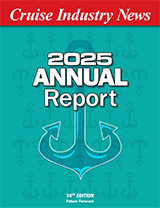As an emerging cruise destination in Asia, the Philippines is working to attract more cruise ships and cruise brands to its shores.
With 121 cruise calls and 140,000 passengers expected to arrive in 2024, the country is going after different niches of the global cruise market.
According to Paulo Benito Tugbang, director for product and market development at the Philippine Department of Tourism, the main focus is on expedition and luxury vessels, but there’s also potential for contemporary vessels and even homeporting operations.
“We are building interest from cruise ships, trying to attract ships from different segments because we really want everyone to discover that the Philippines has a lot to offer,” he told Cruise Industry News during an exclusive interview.
“In our experience, expedition cruises really like to visit exotic destinations and to be able to explore virgin islands and untouched nature,” he continued.
The Philippines is well suited for these kinds of activities, Tugbang explained, with several exotic ports of call to be discovered.
Another big market for the country comes from upscale cruise lines, he noted, with companies like Seabourn being frequent visitors.
“These brands also like to visit untouched places and really have a bespoke experience,” Tugbang explained.
According to Tugbang, the government recently had conversations with The Ritz-Carlton Yacht Collection to explore plans for future calls.
“Our strategy includes building up a portfolio that also features more mega-cruises, the big ships that are more family-friendly,” Tugbang explained.
With a year-round cruise season, the country offers various port options, he added, including eight that are regular cruise destinations.
The country is divided into three major island groups, and all of them currently being visited by cruise ships.
“Part of our strategy as one of the newer players in Southeast Asia is to ramp up our experiences, the things that we want to share with the cruise travelers,” he said.
The initiative includes showing the guests the country’s cultural assets, Tugbang explained, in addition to introducing new islands and destinations.
“We are strategically placed in the center of the Asia-Pacific region and offer a cultural mix of a lot of influences, which is an advantage,” he noted.
In the future, the Philippines could also serve as a homeport for cruise ships, with Manila being especially fit for the role, he added.
“Manila is our best bet. We have a new player coming to improve our airport and make it bigger and even more accessible,” Tugbang highlighted.
The government is also working to build additional airports across the country, improving accessibility to different islands.
Developing port infrastructure is part of the country’s plans as well, with a five-year investment plan already in the pipeline.
“Our Tourism Department is working along with our Philippines Ports Authority and our cruise ports in five major destinations to build cruise terminals,” he explained.
“It’s really a whole-government approach and effort to ramp up The Philippines’ role in Asia’s cruising playground, positioning ourselves as one of the best new destinations in the region,” he said




